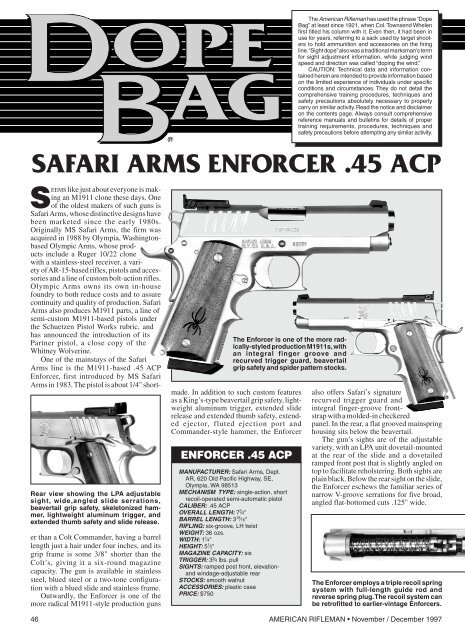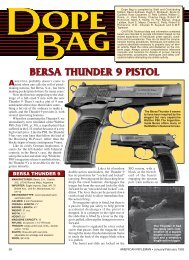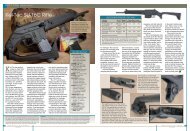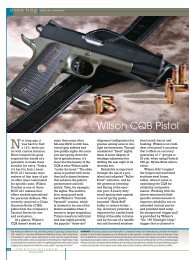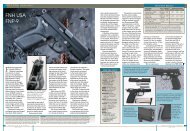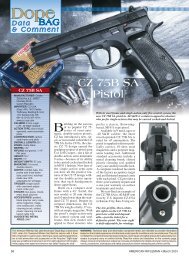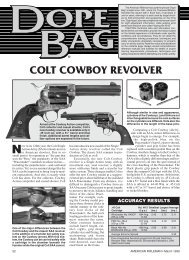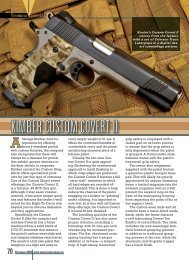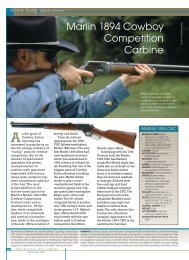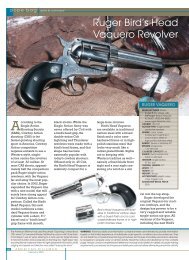shorter
SAFARI ARMS ENFORCER .45 ACP - The National Firearms Museum
SAFARI ARMS ENFORCER .45 ACP - The National Firearms Museum
You also want an ePaper? Increase the reach of your titles
YUMPU automatically turns print PDFs into web optimized ePapers that Google loves.
S<br />
EEMS like just about everyone is making<br />
an M1911 clone these days. One<br />
of the oldest makers of such guns is<br />
Safari Arms, whose distinctive designs have<br />
been marketed since the early 1980s.<br />
Originally MS Safari Arms, the firm was<br />
acquired in 1988 by Olympia, Washingtonbased<br />
Olympic Arms, whose products<br />
include a Ruger 10/22 clone<br />
with a stainless-steel receiver, a variety<br />
of AR-15-based rifles, pistols and accessories<br />
and a line of custom bolt-action rifles.<br />
Olympic Arms owns its own in-house<br />
foundry to both reduce costs and to assure<br />
continuity and quality of production. Safari<br />
Arms also produces M1911 parts, a line of<br />
semi-custom M1911-based pistols under<br />
the Schuetzen Pistol Works rubric, and<br />
has announced the introduction of its<br />
Partner pistol, a close copy of the<br />
Whitney Wolverine.<br />
One of the mainstays of the Safari<br />
Arms line is the M1911-based .45 ACP<br />
Enforcer, first introduced by MS Safari<br />
Arms in 1983. The pistol is about 1/4" <strong>shorter</strong><br />
than a Colt Commander, having a barrel<br />
length just a hair under four inches, and its<br />
grip frame is some 3/8" <strong>shorter</strong> than the<br />
Colt’s, giving it a six-round magazine<br />
capacity. The gun is available in stainless<br />
steel, blued steel or a two-tone configuration<br />
with a blued slide and stainless frame.<br />
Outwardly, the Enforcer is one of the<br />
more radical M1911-style production guns<br />
®<br />
made. In addition to such custom features<br />
as a King’s-type beavertail grip safety, lightweight<br />
aluminum trigger, extended slide<br />
release and extended thumb safety, extended<br />
ejector, fluted ejection port and<br />
Commander-style hammer, the Enforcer<br />
The American Rifleman has used the phrase “Dope<br />
Bag” at least since 1921, when Col. Townsend Whelen<br />
first titled his column with it. Even then, it had been in<br />
use for years, referring to a sack used by target shooters<br />
to hold ammunition and accessories on the firing<br />
line.“Sight dope”also was a traditional marksman’s term<br />
for sight adjustment information, while judging wind<br />
speed and direction was called “doping the wind.”<br />
CAUTION: Technical data and information contained<br />
herein are intended to provide information based<br />
on the limited experience of individuals under specific<br />
conditions and circumstances. They do not detail the<br />
comprehensive training procedures, techniques and<br />
safety precautions absolutely necessary to properly<br />
carry on similar activity. Read the notice and disclaimer<br />
on the contents page. Always consult comprehensive<br />
reference manuals and bulletins for details of proper<br />
training requirements, procedures, techniques and<br />
safety precautions before attempting any similar activity.<br />
SAFARI ARMS ENFORCER .45 ACP<br />
Rear view showing the LPA adjustable<br />
sight, wide,angled slide serrations,<br />
beavertail grip safety, skeletonized hammer,<br />
lightweight aluminum trigger, and<br />
extended thumb safety and slide release.<br />
The Enforcer is one of the more radically-styled<br />
production M1911s,with<br />
an integral finger groove and<br />
recurved trigger guard, beavertail<br />
grip safety and spider pattern stocks.<br />
ENFORCER .45 ACP<br />
MANUFACTURER: Safari Arms, Dept.<br />
AR, 620 Old Pacific Highway, SE,<br />
Olympia, WA 98513<br />
MECHANISM TYPE: single-action, short<br />
recoil-operated semi-automatic pistol<br />
CALIBER: .45 ACP<br />
OVERALL LENGTH: 7 3 ⁄4"<br />
BARREL LENGTH: 3 15 ⁄16"<br />
RIFLING: six-groove, LH twist<br />
WEIGHT: 36 ozs.<br />
WIDTH: 1 1 ⁄4"<br />
HEIGHT: 5 1 ⁄2"<br />
MAGAZINE CAPACITY: six<br />
TRIGGER: 3 3 ⁄4 lbs. pull<br />
SIGHTS: ramped post front, elevationand<br />
windage-adjustable rear<br />
STOCKS: smooth walnut<br />
ACCESSORIES: plastic case<br />
PRICE: $750<br />
also offers Safari’s signature<br />
recurved trigger guard and<br />
integral finger-groove frontstrap<br />
with a molded-in checkered<br />
panel. In the rear, a flat grooved mainspring<br />
housing sits below the beavertail.<br />
The gun’s sights are of the adjustable<br />
variety, with an LPA unit dovetail-mounted<br />
at the rear of the slide and a dovetailed<br />
ramped front post that is slightly angled on<br />
top to facilitate reholstering. Both sights are<br />
plain black. Below the rear sight on the slide,<br />
the Enforcer eschews the familiar series of<br />
narrow V-groove serrations for five broad,<br />
angled flat-bottomed cuts .125" wide.<br />
The Enforcer employs a triple recoil spring<br />
system with full-length guide rod and<br />
reverse spring plug.The recoil system can<br />
be retrofitted to earlier-vintage Enforcers.<br />
46 AMERICAN RIFLEMAN • November / December 1997
Aiding in recoil control<br />
is the Enforcer’s<br />
grooved, checkered<br />
frontstrap.<br />
The gun’s beveled<br />
magazine well<br />
helps speed magazine<br />
changes.<br />
Adding to the pistol’s external distinctiveness<br />
are its smooth walnut stocks with a<br />
black widow spider design. At the bottom<br />
of the pistol’s butt, the magazine well has<br />
also been beveled to enable speedier magazine<br />
insertion.<br />
Internally, the Enforcer is of familiar<br />
M1911 design, but with a few twists, such<br />
as its triple-coil spring recoil system and its<br />
large-diameter barrel, which mates directly<br />
with the slide, eliminating the barrel bushing.<br />
The new recoil system replaces the<br />
fatigue-prone single- and dual-coil systems<br />
on older Enforcers (which, according to<br />
Safari Arms, can be retrofitted with it).<br />
In addition to the new recoil system,<br />
current Enforcers are also subtly improved<br />
in the areas of tuning, throating, polishing<br />
and similar reliabilityenhancing<br />
modifications.<br />
The Enforcer retains the<br />
M1911 grip and thumb<br />
safeties, but lacks the Colt<br />
Series 80-type passive firing<br />
pin block.<br />
Our test stainless steel<br />
Enforcer showed evidence<br />
of good quality control,<br />
being devoid of pits or other<br />
common casting flaws. Fit<br />
and finish were generally<br />
good, with about an average<br />
degree of slide/frame play,<br />
and a bit of a gap between<br />
the beavertail and the frame.<br />
We fired the Enforcer for accuracy with<br />
the results listed in the accompanying table,<br />
and function-fired the pistol with Black<br />
Hills, CCI, Federal, Hornady, Remington<br />
and Winchester ammunition. Out of some<br />
120 rounds, there was a single malfunction,<br />
a smokestack jam with target ammunition.<br />
Our Enforcer exhibited only moderate<br />
recoil even with heavy +P .45 ACP loads,<br />
probably thanks to its stiff triple-recoil<br />
spring system. The finger groove and<br />
checkered panel seemed to aid in recoil<br />
control, though the groove did not fit all<br />
hands equally. High marks were given to<br />
the gun’s sights, 3 3 ⁄4-lb. trigger and extended<br />
thumb safety (though some complained<br />
of sharp edges on the beavertail and finger<br />
groove). One shooter also reported that his<br />
thumb tended to engage the pistol’s thumb<br />
ACCURACY RESULTS<br />
.45 ACP Vel. @15' Smallest Largest Average<br />
Cartridge (f.p.s.) (ins.) (ins.) (ins.)<br />
Fed. No. P45HS1 794 Avg. 2.19 4.43 3.46<br />
230-gr. HS<br />
27 Sd<br />
Hdy. No. 9111 853 Avg. 2.26 4.10 2.86<br />
200-gr. FMJ Match 19 Sd<br />
Win. No. X45ASHP2 862 Avg. 2.65 6.04 4.22<br />
185-gr. ST<br />
35 Sd<br />
Average Extreme Spread 3.51<br />
Five consecutive five-shot groups from 25 yds., fired from<br />
sandbags. Abbreviations: Sd (standard deviation), Fed.<br />
(Federal), FMJ (full metal jacket), Hdy. (Hornady), HS (Hydra-<br />
Shok), ST (Silvertip), Win. (Winchester)<br />
safety while shooting using a high grip.<br />
The Enforcer joins the approximate<br />
length of a Colt Commander with the frame<br />
length of an Officer’s ACP, giving a more<br />
discreet profile when worn vertically, as in<br />
a belt or inside-the-pants holster. Note that<br />
the Enforcer will fit in many, but not all, holsters<br />
for the Colt Commander. Many holstermakers<br />
offer models specifically for the<br />
Enforcer; the latest Olympic Arms catalog<br />
has a list of several of these.<br />
The Safari Arms Enforcer may not be<br />
everyone’s ideal as the ultimate .45 ACP<br />
carry gun. However, many will gladly<br />
accept the Enforcer’s weight and size as a<br />
good trade-off for its controllable recoil.<br />
The gun should appeal to fans of<br />
Commander-size M1911s and those who<br />
are drawn to its unique styling.<br />
TIKKA MODEL 595 SPORTER<br />
C<br />
The Tikka 595 Sporter is a new model, based on the<br />
proven 595 action, that is suitable for both target<br />
shooting as well as the police counter-sniper role.<br />
ENTER-FIRE bolt-action target rifles<br />
for NRA highpower or International<br />
Shooting Union (ISU) competition<br />
are generally characterized by heavy barrels,<br />
light, crisp triggers, and (in some disciplines)<br />
stocks offering cheekpiece and<br />
buttplate adjustments and a fore-end accessory<br />
rail—features also demanded by many<br />
contemporary police marksmen.<br />
Such specialized precision does not<br />
come cheap, however. Even the least expensive<br />
of these rifles runs more than $1,000,<br />
with most costing around $2,600 to more<br />
than $8,000—a price that can easily preclude<br />
purchase of such a rifle by either a wouldbe<br />
target competitor or a smaller police<br />
department. The Tikka 595 Sporter, introduced<br />
in 1997, offers many of the features<br />
most desired by competitors and police<br />
marsmen, and at a more affordable cost.<br />
In general description, the 595 Sporter<br />
is a bolt-action repeater with a mediumheavy,<br />
23 3 ⁄4" barrel, a flat-bottomed receiver<br />
with an integral dovetail for scope base<br />
mounting, a detachable five-round magazine,<br />
an adjustable single-stage trigger and<br />
a target-style hardwood stock adjustable for<br />
comb height, length of pull and buttplate<br />
position. Currently the Sporter is currently<br />
available in the U.S. in .308 Win. only; other<br />
target-type chamberings may follow.<br />
Turnbolt actions for serious accuracy<br />
work have a rigid receiver with thick walls,<br />
minimal cutouts for the ejection port and<br />
magazine, and plenty of bedding area. Most<br />
commonly employ a two-lug bolt (a design<br />
AMERICAN RIFLEMAN • November / December 1997 47
A serrated button in the right side of the<br />
stock is depressed to release the singlecolumn<br />
five-round magazine. Magazine<br />
release can also be performed with the left<br />
hand reaching around under the stock.<br />
that still dominates bench-rest competition).<br />
The action of the 595 Sporter has all<br />
these characteristics. Its investment-cast<br />
receiver is 1.28" wide, 1.25" high and 8.6"<br />
long, with a wall thickness outside the locking<br />
lug raceways of .17" and a .110" high<br />
and .650" wide dovetail for scope base<br />
mounting along the receiver top.<br />
On many repeating bolt actions, the ejection<br />
port and magazine openings leave (on<br />
right-handed actions) a relatively thin right<br />
siderail—a less-than-optimal situation for<br />
maximum rigidity and accuracy. The 595’s<br />
siderail is as substantial as we’ve ever<br />
seen—.63" high at the ejection port and<br />
more than .3" thick—due to both the receiver’s<br />
flat-bottomed design and the gun’s single-column<br />
five-round magazine, which<br />
requires a narrower cut through the receiver<br />
floor than do the typical staggered-column<br />
boxes used on many other bolt guns.<br />
The 595’s bolt is machined from bar<br />
stock and has a .682" diameter body and<br />
.921" diameter lug circle. Calculated lug<br />
TIKKA 595 SPORTER<br />
MANUFACTURER: Sako, Ltd., Box 149,<br />
11101 Riihimaki, Finland<br />
IMPORTER: Stoeger Industries, Dept.<br />
AR, 5 Mansard Court, Wayne, NJ<br />
07470<br />
MECHANISM TYPE: bolt-action rifle<br />
CALIBER: .308 Win. (tested),<br />
OVERALL LENGTH: 44"<br />
BARREL LENGTH: 23 3 ⁄4"<br />
RIFLING: four groove 1:11"RH twist<br />
WEIGHT: 9 1 ⁄2 lbs.<br />
MAGAZINE CAPACITY: five<br />
TRIGGER: single-stage, 3 lbs. pull<br />
SIGHTS: none; receiver drilled, tapped<br />
and dovetail-contoured for scope<br />
mounts<br />
STOCK: European walnut; cheekpiece<br />
adjustable for height, buttpad<br />
adjustable for pitch<br />
ACCESSORIES: none<br />
PRICE: $875<br />
bearing area is on the order of .079 sq. in.,<br />
while shear area is some .40 sq. in.—about<br />
the same as other modern high-strength<br />
actions. The bolt head is integral with the<br />
bolt body and contains a Sako-style extractor<br />
and a plunger ejector, and is counterbored<br />
about .11".<br />
At the rear of the bolt, a single helical<br />
camming surface cocks the firing pin. The<br />
bolt handle is neither welded to, nor integral<br />
with the bolt; its inboard end fits into a dovetail<br />
cut in the bolt body. During bolt disassembly<br />
(detailed in the Tikka Owner’s<br />
Manual) the handle may be removed, along<br />
with the firing pin, cocking piece and synthetic<br />
bolt shroud. Bolt disassembly is not<br />
normally required for routine maintenance.<br />
Bolt removal is accomplished by simultaneously<br />
retracting the bolt and depressing<br />
the bolt stop lever set into the left receiver<br />
wall. The stop’s beveled rear face is overridden<br />
when the bolt is reinserted.<br />
The barrel of the 595 is a medium-heavy<br />
tube that tapers from 1.12" at the receiver to<br />
.785" at the muzzle, and the crown is<br />
Two aluminum rods in the comb lock into<br />
the stock by hex-head screws (arrows);<br />
loosening these screws allows comb<br />
height adjustment. The butt moves vertically<br />
and laterally by loosening a machine<br />
screw under the buttpad; length of pull can<br />
be modified by way of .2"-thick spacers.<br />
recessed. The four-groove hammer-forged<br />
rifling has (in .308 Win.) a 1:11" RH twist.<br />
The Sporter’s trigger is user-adjustable<br />
from two to four pounds pull by way of a<br />
hex-headed screw in the forward face of the<br />
trigger unit that is accessible upon removalof<br />
the action from the stock.<br />
At the rear right side of the action is the<br />
Sporter’s serrated safety button, which in<br />
the rearward, “safe” position blocks both<br />
trigger and bolt. Moving the safety forward<br />
to the “fire” position frees both parts and<br />
also exposes a red dot on the receiver tang.<br />
When the rifle is cocked a red-painted indicator<br />
protrudes from under the bolt shroud.<br />
The 595 Sporter’s most distinctive feature<br />
is probably its stock, which slightly<br />
resembles that of the British Accuracy<br />
International sniper rifle. Made of European<br />
walnut, the stock features a wide channel for<br />
the free-floating barrel; stippling in all gripping<br />
areas; a nearly vertical handgrip with<br />
palm swell for prone, bipod or sandbag<br />
shooting; a 8.12"-long accessory rail running<br />
along the downward-sloping underside<br />
of the fore-end, a left-side mounting plate<br />
for a sling; and an adjustable comb and<br />
buttplate. The straight comb is mounted on<br />
a pair of vertical metal rods that are clamped<br />
in place by two hex-headed screws set into<br />
the buttstock ’s right and which allow 1 3 ⁄4"<br />
of vertical adjustment. Length of pull is<br />
adjusted by adding or removing .2"-thick<br />
spacers between the buttpad and its mounting<br />
plate. Removing the buttpad and loosening<br />
a large hex screw allows the buttpad<br />
to be moved vertically along the curved butt,<br />
as well as pivoted inward or outward.<br />
Surprisingly, the stock, though well<br />
sealed against moisture, showed no traces<br />
of bedding compound. The Sporter’s recoil<br />
lug is a separate, thick L-shaped aluminum<br />
piece having a hole centered in the longer,<br />
horizontal side that engages a same-size<br />
boss around the forward stock screw hole in<br />
the receiver, and a <strong>shorter</strong> leg that projects<br />
downward into a stock recess. When the<br />
receiver is in the stock, it is locked securely<br />
to the recoil lug which, in turn, butts up<br />
against the face of its stock recess. The recoil<br />
lug is loose in the stock, so care must be<br />
taken not to lose it during disassembly.<br />
Magazine retention is via a serrated button<br />
set into the right side of the stock. In normal<br />
operation, the magazine catch would be<br />
operated by curving the left hand under the<br />
stock and depressing the button with the fingertips<br />
of the left hand. This positions the<br />
hand to catch the freed magazine, whose<br />
release is assisted by a small spring-loaded<br />
plunger in the lip of the magazine well that<br />
pushes against the magazine’s plastic<br />
basepad. The steel-bodied magazines feature<br />
a synthetic follower, and may be disassembled<br />
for cleaning.<br />
The 595 Sporter is not supplied with<br />
sights, but the receiver is drilled and tapped<br />
and is equipped with the aforementioned<br />
integral dovetail rail designed for Tikka<br />
bases, which feature a recoil stop pin in the<br />
forward base that engages a semicircular<br />
recess in the top of the receiver just forward<br />
of the ejection port. The interior surfaces of<br />
the steel rings accept rounded one-piece<br />
flexible synthetic inserts that rotate to fit<br />
around a 1" scope tube without any torsional<br />
1<br />
The right-side view of the Tikka 595 action<br />
shows the (1) safety, (2) trigger adjustment<br />
screw, (3) thick right siderail and (4) boss<br />
that engages hole in L-shaped recoil lug.<br />
2<br />
3<br />
4<br />
48 AMERICAN RIFLEMAN • November / December 1997
stress, similar in principle to the Burris Pos-<br />
Align system. Target iron sights should be<br />
easily installed by a competent gunsmith.<br />
To disassemble the Sporter, first ensure<br />
that the magazine is removed and the chamber<br />
empty. Turn out and remove the front<br />
and rear stock screws; be careful not to lose<br />
their respective washers. Lift the barreled<br />
action free of the receiver, heeding the aforementioned<br />
caution regarding the loose<br />
recoil lug. No further disassembly is<br />
required for maintenance or cleaning.<br />
ACCURACY RESULTS<br />
.308 Win. Vel. @15' Smallest Largest Average<br />
Cartridge (f.p.s.) (ins.) (ins.) (ins.)<br />
Fed. No. 308M 2519 Avg 0.37 0.65 0.49<br />
168-gr. HPBT Match 13 Sd<br />
PMC No. 308 SMB 2644 Avg. 1.22 1.68 1.38<br />
168-gr. HPBT Match 15 Sd<br />
White Feather. 2631 Avg. 0.49 0.82 0.65<br />
175-gr. HPBT Match 11 Sd<br />
Average Extreme Spread 0.84<br />
Five consecutive five-shot groups from 100 yds., fired from sandbags.<br />
Abbreviations: Sd (standard deviation), Fed. (Federal),<br />
HPBT (hollow-point boattail)<br />
Reassemble the rifle in the reverse order.<br />
We fired our sample 595 Sporter for<br />
accuracy with the results reported in the<br />
accompanying table, and function-fired it<br />
with Black Hills, Federal, PMC, Remington<br />
and White Feather ammunition. There were<br />
no malfunctions. The gun’s trigger was<br />
excellent, breaking at a dead crisp 3 lbs., and<br />
bolt operation was extremely smooth.<br />
The Tikka showed exceptional accuracy<br />
with both Federal and White Feather<br />
match ammunition. The rifle’s .49" average<br />
group size with<br />
Federal loads—praiseworthy<br />
performance in a<br />
match rifle costing<br />
$2,000 or more—is astonishing<br />
in a factory,<br />
wood-stocked rifle at the<br />
Tikka’s $875 list price.<br />
Although the gun’s<br />
nominal 1:11" rifling<br />
twist is theoretically<br />
optimal for projectiles<br />
of 168 grs. or less, good<br />
results were obtained<br />
with White Feather<br />
loads with Sierra’s 175-<br />
gr. MatchKing.<br />
The 595 uses a two-lug bolt with a plunger<br />
ejector and Sako-style extractor.The notch<br />
in the upper lug is for the bolt guide rib.<br />
We found few faults with the Sporter.<br />
We’d like to see an optional stainless<br />
match-grade barrel, a metal bolt shroud and<br />
bottom metal to replace the (functionally<br />
adequate) plastic units supplied with the<br />
rifle and a fully adjustable synthetic stock<br />
(the latter item is reportedly under consideration).<br />
Yet even without these changes<br />
(which would increase its cost), the 595<br />
Sporter remains a very reasonably priced<br />
rifle with the adjustability, trigger quality<br />
and pinpoint accuracy required by both target<br />
shooters and police marksmen.<br />
REMINGTON 11-96 LIGHTWEIGHT<br />
S<br />
The new Remington 11-96 Euro Lightweight, popular<br />
at the IWA firearms show in Germany, features a<br />
lightened steel receiver as well as the pressurecompensated,<br />
low-recoil gas system of the 11-87.<br />
OMETIMES bigger isn’t necessarily<br />
better. This is especially true with<br />
rifles that may need to be lugged up<br />
steep mountains at high altitudes or handguns<br />
that are legally tucked away on the<br />
body. The shotgun isn’t absolved from this<br />
requisite, either. To that end, Remington<br />
Arms recently introduced its Model 11-96<br />
Euro Lightweight, reviewed here.<br />
As its name suggests, the Euro<br />
Lightweight has European influence.<br />
According to Jay Bunting, Remington’s<br />
firearms business unit manager, “The<br />
European market told us that they [sic]<br />
wanted an ultra-light autoloader that was<br />
as good as a Remington 11-87 ... . The 11-<br />
96 was so well received at the IWA<br />
firearms trade expo in Germany that we<br />
decided that we should introduce it here in<br />
the United States.”<br />
The sample 11-96 shotgun we received<br />
sported a light-colored Claro walnut stock<br />
with 22 line-per-inch cut checkering on the<br />
pistol grip and fore-end, and a 1/2" thick<br />
solid rubber recoil pad.<br />
Unlike the aluminum receivers of most<br />
other lightweight autoloading shotguns,<br />
particularly European ones, the 11-96’s<br />
receiver is machined from a single<br />
block of steel that has a “hump-back”<br />
profile where superfluous metal is<br />
removed. Scroll and floral engraving<br />
embellishes the side panels, and the<br />
lightweight trigger guard is made using<br />
a metal injection molding process.<br />
Like the 11-87, the 11-96 employs<br />
Remington’s pressure-compensated,<br />
low recoil gas system that is touted to<br />
handle both 2 3 ⁄4" field and 3" magnum<br />
shotshells.<br />
Another weight-saving step was to<br />
shorten the tubular magazine assembly,<br />
giving the 11-96 a capacity of three in the<br />
magazine and one in the chamber. A magazine<br />
plug, included with each gun, limits<br />
the total capacity to three to comply with<br />
the Federal Migratory Bird Treaty Act.<br />
Visible here is the right-hand action bar,<br />
the shortened tubular magazine, and the<br />
Euro Lightweight’s gas piston assembly.<br />
AMERICAN RIFLEMAN • November / December 1997 49
Both 26" and 28" ventilated rib Rem<br />
Choke barrels are offered. Our sample<br />
came with the latter having a single .058"<br />
brass bead on the 6 mm rib. Both length<br />
barrels are of chrome-moly steel and have<br />
chrome-plated bores and are of lightweight<br />
contour so they should not be overbored<br />
or polished. Three flush-fitting Rem<br />
Choke tubes for lead or steel shot and a<br />
tube wrench are supplied.<br />
The NRA staff was first introduced to<br />
the Remington Model 11-96 Euro<br />
Lightweight during the 1996 Remington<br />
Writer’s Seminar at Remington’s new<br />
world headquarters in Madison, North<br />
REMINGTON 11-96<br />
MANUFACTURER: Remington Arms<br />
Company, Inc., Dept. AR, 870<br />
Remington Dr., Madison, NC<br />
27025-0700<br />
MECHANISM TYPE: gas-operated,<br />
semi-automatic shotgun<br />
GAUGE: 12, 3"<br />
OVERALL LENGTH: 48 1 ⁄4"<br />
BARREL LENGTH: 26", 28" (tested)<br />
WEIGHT: 7 lbs., 5 ozs.<br />
MAGAZINE CAPACITY: three<br />
TRIGGER: single stage, 4 1 ⁄2 lbs. pull<br />
STOCK: Claro walnut: length of pull,<br />
13 7 ⁄8"; drop at heel, 2"; drop at<br />
comb, 1 1 ⁄2"<br />
ACCESSORIES: three choke tubes,<br />
choke tube spanner<br />
PRICE: $862<br />
N<br />
EVER one to “stay with the<br />
flock,” Modern Muzzleloading’s<br />
HK-94 in-line<br />
muzzleloading pistol departs radically<br />
from traditional lines. Black<br />
and beige laminated hardwood is<br />
used for its stock that is reminiscent of<br />
that of the Remington XP-100.<br />
At the rear of the trigger guard is a single<br />
stock bolt that screws into the trigger<br />
housing, which is attached with three hexhead<br />
screws to the receiver. This housing<br />
contains the manual trigger-blocking<br />
cross-bolt safety and trigger; instructions<br />
on adjusting the latter are in the owner’s<br />
manual. The safety can be switched to lefthand<br />
operation by a qualified gunsmith.<br />
A slight step at the rear of the tapered<br />
12" stainless steel barrel gives the appearance<br />
that barrel and receiver are two separate<br />
pieces, but they are in fact one, giving<br />
the gun added rigidity. The breech plug<br />
is stainless steel and is drilled and tapped<br />
at its rear for a removable nipple that takes<br />
a standard No. 11 percussion cap.<br />
The action is glass bedded in the stock<br />
at the two rear-most surfaces of the trigger<br />
housing, and the black aluminum ramrod<br />
is retained beneath the barrel by a flat<br />
spring screwed into the stock at the bottom<br />
rear of the ramrod channel.<br />
The hammer and its operation are the<br />
REMINGTON<br />
AVERAGE OF 10 PATTERNS<br />
AT 40 YDS.<br />
16 13<br />
28 28<br />
31 28<br />
22 16<br />
Modified Tube<br />
= Point of Hold<br />
Sovereign Aristocrat 3 3 ⁄4-1 1 ⁄4-6<br />
Pellet count=281<br />
Total Hits 182 (65%)<br />
21.2" Inner Circle 115 (41%)<br />
30" Outer Ring 67 (24%)<br />
KNIGHT HK-94 HAWKEYE<br />
The Knight HK-94 Hawkeye muzzleloading<br />
pistol has styling reminiscent of the<br />
Remington XP-100,and incorporates the<br />
hammer safety of Knight’s MK-85 rifle.<br />
Carolina. During a seminar-sponsored<br />
hunt for<br />
pheasants at the Primland<br />
Hunt Preserve, our staffers<br />
found the guns pleasant<br />
to carry even though<br />
the pheasant fields on the<br />
side of a mountain, where<br />
a heavier gun would have<br />
been taxing. Functioning<br />
was 100% reliable for several<br />
boxes of Remington<br />
Premier Field Loads fired<br />
during the intermittent<br />
drizzle that dampened an<br />
otherwise fine shoot.<br />
Though we did not<br />
witness it, other writers<br />
who had chosen to shoot<br />
ducks reported some split<br />
fore-ends under the recoil<br />
of the heavy steel magnum<br />
loads. Remington<br />
also reported that some<br />
fore-ends split during<br />
shipping. These guns<br />
were early prototypes,<br />
however, and our production<br />
gun had its fore-end<br />
reinforced with fiberglass<br />
cloth at the receiver and a<br />
brass through-bolt near the<br />
magazine cap. Function<br />
firing several boxes of<br />
magnum steel loads produced<br />
no splitting in our<br />
sample’s fore-end, so<br />
this problem seems to<br />
have been corrected.<br />
The Remington 11-<br />
96 Euro Lightweight<br />
was patterned at 40 yds.<br />
with the results shown in<br />
the accompanying table.<br />
We had no malfunctions,<br />
even with several boxes<br />
of Remington’s Premier<br />
1 oz., 2 3 ⁄4 dram-equivalent<br />
Target Load. Although<br />
the gun tips the<br />
scales at little more than<br />
seven pounds, recoil—<br />
even with 1 3 ⁄8 oz. of magnum<br />
steel shot—was<br />
light, thanks to the gun’s<br />
fit and gas system.<br />
Aesthetically, the<br />
new receiver profile took<br />
some time to accept, and<br />
there was concern that its<br />
stepped contour could be<br />
distracting when shooting.<br />
We found, however,<br />
no distraction, and that<br />
the gun was pleasant to<br />
shoot and carry.<br />
A fiberglass cloth patch<br />
is used to reinforce the<br />
Remington’s fore-end<br />
forward of the receiver.<br />
same as that of the Knight MK-<br />
85 series rifles (November 1990, p. 54). As<br />
with the MK-85, the HK-94 Hawkeye uses<br />
a patented secondary safety at the rear of<br />
the hammer that screws down toward the<br />
end cap to prevent the hammer from falling<br />
50 AMERICAN RIFLEMAN • November / December 1997
far enough forward to strike a percussion<br />
cap should the trigger be unintentionally<br />
pulled. When the secondary safety is<br />
turned to the off position, a red annular ring<br />
can be seen on the hammer screw.<br />
The trigger is<br />
pinned at its middle<br />
and attached<br />
to a trigger bar at<br />
its top. When the<br />
trigger is pulled,<br />
the trigger bar is<br />
drawn forward<br />
along with a<br />
stepped sear release<br />
that is attached<br />
to its rear.<br />
As the sear release<br />
moves forward,<br />
the sear<br />
drops from the<br />
The leg can be used to support the<br />
Hawkeye during loading (above l.). The<br />
drilled and tapped holes in the Hawkeye’s<br />
receiver (r.) allow the mounting of a telescopic<br />
sight or the supplied iron sights.<br />
step, allowing the hammer to fly forward<br />
and strike the percussion cap. The trigger<br />
is returned to the forward position by a coil<br />
spring.<br />
The Hawkeye comes equipped with a<br />
fully-adjustable Williams rear sight and a<br />
KNIGHT HK-94<br />
MANUFACTURER: Modern<br />
Muzzleloading, Inc., Dept. AR, P.O.<br />
Box 130, 234 Airport Rd., Centerville,<br />
IA 52544<br />
MECHANISM TYPE: in-line percussion<br />
muzzleloading pistol<br />
CALIBER: .50<br />
OVERALL LENGTH: 20"<br />
BARREL LENGTH: 12"<br />
WEIGHT: 3 lbs., 4 ozs.<br />
WIDTH: 1 3 ⁄4"<br />
HEIGHT: 6 1 ⁄2"<br />
RIFLING: eight-groove, 1:20" RH twist<br />
TRIGGER: single-stage adjustable,<br />
4 1 ⁄2 lbs. pull<br />
SIGHTS: Williams adjustable blade rear,<br />
hooded gold-bead front<br />
ACCESSORIES: instructional video,<br />
three hex wrenches, combo tool, sample<br />
pack of bullets<br />
PRICE: $449.95 (stainless) $399.95<br />
(blued)<br />
hooded gold-bead front sight. The pistol is<br />
drilled and tapped for Warne bases or<br />
Weaver No. 45 scope bases.<br />
To load the Hawkeye, begin by screwing<br />
a cleaning jag onto the end of the ramrod<br />
and pushing a clean patch down the<br />
barrel until it stops against the breech plug.<br />
With the ramrod in this position, point the<br />
Hawkeye in a safe direction, place a cap<br />
on the nipple and fire the cap. Repeat this<br />
process several times to clear the nipple.<br />
Pull the ramrod from the barrel. The<br />
patch should be blackened, or have a hole<br />
burned through it, indicating a clear nipple<br />
and flash channel. Place the push-button<br />
and secondary safeties on and confirm there<br />
is no percussion cap or cap residue on the<br />
nipple. Step on a raised surface to elevate<br />
your knee so that the Hawkeye can be supported<br />
on your thigh during loading. For the<br />
rest of the process keep the muzzle pointed<br />
away from you.<br />
Pour a pre-measured<br />
powder charge<br />
down the barrel from a<br />
powder measure. Never<br />
pour directly from a<br />
flask. Tap the side of the<br />
barrel to settle the powder,<br />
and insert a proper<br />
size muzzleloading<br />
projectile into the muzzle. Start the bullet<br />
into the bore using a short starter, then seat<br />
it fully against the powder charge using the<br />
ramrod by holding around, not over, the<br />
ramrod. Don’t pound or bounce the ramrod;<br />
blackpowder and Pyrodex are impact sensitive<br />
and could ignite.<br />
Next, remove the ramrod, point the<br />
Hawkeye down range and pull back on the<br />
knurled hammer screw until the hammer<br />
locks into the cocked position. Ensure both<br />
the push-button and secondary safeties are<br />
on safe, then place a No. 11 percussion cap<br />
on the nipple. The pistol is now loaded.<br />
It is necessary to use a patch on the ramrod<br />
and fire caps to ensure the nipple is<br />
clear only after the Hawkeye has been<br />
cleaned—not between shots.<br />
To disassemble the unloaded<br />
Hawkeye for cleaning,<br />
remove the ramrod and turn<br />
out the hex-headed stock<br />
screw from the rear of the trigger<br />
guard and lift the barreled<br />
action from the stock. Next,<br />
remove the three hex-headed<br />
screws from the trigger<br />
assembly and lift it from the<br />
receiver. Grasp the knurled<br />
end-cap at the rear of the<br />
receiver and unscrew it until<br />
the hammer assembly can be<br />
pulled free. Insert the supplied<br />
combo tool into the receiver<br />
while pulling the trigger,<br />
engage the nipple and turn it<br />
A secondary safety (arrow) can be<br />
screwed forward to prevent the hammer<br />
from contacting a percussion cap should<br />
the gun’s trigger be inadvertently pulled.<br />
out. Reverse the combo tool, reinsert it into<br />
the action and unscrew the breech plug.<br />
Reassembly is in the reverse order. It is<br />
important to lightly grease the nipple and<br />
breech plug threads and hand tighten only.<br />
Remember to pull the trigger as you insert<br />
the hammer assembly to lower the sear.<br />
The Hawkeye fitted with a Tasco 4x28<br />
extended-eye-relief scope was fired for<br />
accuracy at 50 yds. with blackpowder,<br />
Black Canyon and Pyrodex loads using<br />
muzzleloading bullets and bullets in sabots<br />
with the results in the accompanying table.<br />
The owner’s manual suggests loads<br />
between 50 and 70 grs. of blackpowder or<br />
blackpowder equivalent. With the Black<br />
Canyon blackpowder substitute, the 90 gr.<br />
charge is by volume and is equal to a 70-<br />
gr. charge of blackpowder. Heavier<br />
charges are not recommended, and in a 12"<br />
barrel, will likely not yield any more velocity.<br />
All powder charges shown are expressed<br />
in grains, but measured by volume.<br />
The Hawkeye approaches the accuracy<br />
of some muzzleloading rifles, perhaps due<br />
to the added rigidity of the short barrel.<br />
Though the properties of blackpowder<br />
limit the power of this pistol, in the hands<br />
of a skilled shooter using maximum loads<br />
at reasonable ranges, it should be suitable<br />
for medium-size game where legal.<br />
ACCURACY RESULTS<br />
.50 cal. Vel. @15' Smallest Largest Average<br />
Load (f.p.s.) (ins.) (ins.) (ins.)<br />
RWS No. 11 percussion cap<br />
Knight 260-gr. LHPSB 656 Avg. 3.78 4.98 4.36<br />
90.0 grs. Black Canyon 7 Sd<br />
RWS No. 11 percussion cap<br />
T/C 275-gr. M-H 1008 Avg. 3.05 4.71 3.87<br />
60.0 grs. Pyrodex P 16 Sd<br />
CCI No. 11 percussion cap<br />
Buffalo 245-gr. Ball-et 1147 Avg. 2.66 4.64 3.63<br />
70.0 grs. Elephant FFFg 7 Sd<br />
Average Extreme Spread 3.95<br />
Five consecutive five-shot groups from 50 yds., from sandbags.<br />
Abbreviations: Sd (standard deviation), LHPSB (lead hollow-point<br />
sabot), M-H (Maxi-Hunter), T/C (Thompson/Center)<br />
AMERICAN RIFLEMAN • November / December 1997 51


